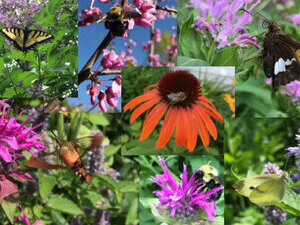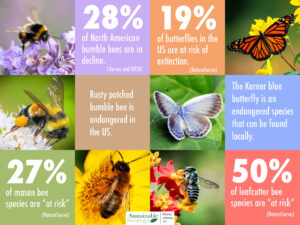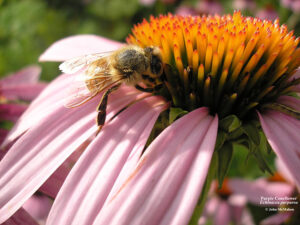Ways to help our pollinators

MAKE YOUR YARD A POLLINATOR HAVEN
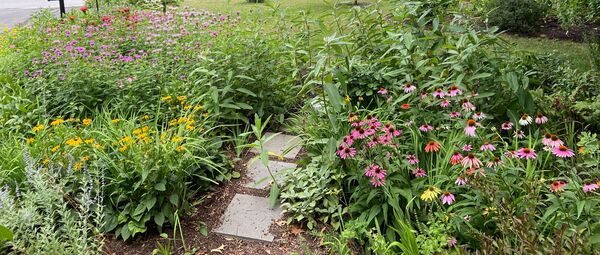
Photo: Wendy Mahaney
Do not use insecticides or herbicides
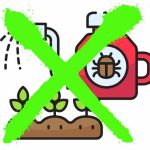 According to NY Audubon, American homeowners use aroud 70 million pounds of “pesticides” on their lawns each year, despite the increasing evidence linking these chemicals to human and environmental health issues. Pesticides do not just harm “pest” insects and weeds, they also harm pollinators and other beneficial insects. Pesticides includes fungicides, herbicides, and insecticides. Do not use them on your lawn and gardens. Look for pollinator-friendly pest control options, such as biocontrol (using beneficial insects to control pests). Learn more from Xerces Society.
According to NY Audubon, American homeowners use aroud 70 million pounds of “pesticides” on their lawns each year, despite the increasing evidence linking these chemicals to human and environmental health issues. Pesticides do not just harm “pest” insects and weeds, they also harm pollinators and other beneficial insects. Pesticides includes fungicides, herbicides, and insecticides. Do not use them on your lawn and gardens. Look for pollinator-friendly pest control options, such as biocontrol (using beneficial insects to control pests). Learn more from Xerces Society.
A special note on Neonicotinoids: Neonicotinoid insecticides (neonics) are now the most widely used class of insecticides in the world, and they have a devastating effect on insects. They last a long time in the environment, including inside the plants. Neonicotinoids are also water-soluble, so they move through the environment easily and move through the soil to neighboring plants and into local waterways. Learn more here.

Provide habitat for pollinators
Nectar nourishes adult bees and butterflies, but you can support them throughout their life cycles by creating favorable habitat for their offspring. Provide host plants for a variety of caterpillars, including milkweed, dill or fennel, black-eyed Susans, coneflowers, goldenrod and asters. Select native trees and shrubs to feed native insects, birds and small mammals; oak trees are particularly important.
Traditional turfgrass lawns are food deserts for pollinators. Making some changes can mean a vast improvement in their quality of life. How about turning a portion of your lawn into a meadow? Read our post here. You can also replace mulch or grass around trees with a “soft landing” space for caterpillars and other insects and small wildlife. Here’s how.
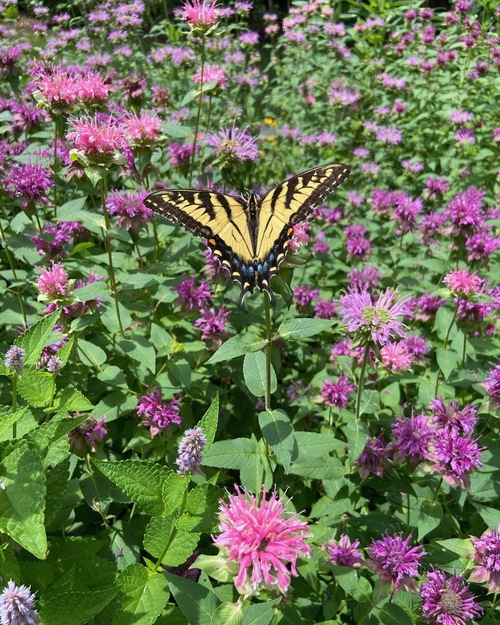 Read the story of one local woman’s quest to turn her entire front yard into a pollinator paradise.
Read the story of one local woman’s quest to turn her entire front yard into a pollinator paradise.
It is also important to provide drinking water. A standard bird bath is okay for our avian friends, but insects need shallow water. A saucer of water with small stones in it is perfect for insects; they can stand on the rocks to drink without the risk of drowning.
Change your lawn care routine: Join the No Mow May movement and delay your first spring mowing to let “weeds” and wildflowers bloom in your yard to feed the earliest pollinators when they emerge. Feed pollinators all season long by reducing how often you mow and letting what’s in your lawn bloom in between mowing. You may even find you have a more lush lawn. Commit to pesticide-free lawn care.
Skip the fall cleanup: Leave the leaves on the ground so native insects, including fireflies, can overwinter in the leaf litter. Hollow plant stems and bare ground are essential overwintering sites for many species. This provides a winter habitat in your garden that wood much doesn’t. Cut back plant stems to about 18 inches, and leave some seed heads standing. Birds such as chickadees and cardinals will feed on the seed heads you leave behind to make it through the winter. Create a brush pile in the corner of your yard; many small creatures overwinter in logs and snags, or in piles of rocks. An ultra-tidy garden is not habitat.
Download a detailed brochure on creating pollinator habitat from Xerces Society

Plant native, pollinator-friendly species
Whether you have room for a window box or an acre, you can create habitat for pollinators! Urban and suburban gardens attract a diverse pollinator community, as long as they have adequate food throughout the summer. Check our our list of native plants to grow for year-round food for pollinators and learn more in our blog post about how to create a pollinator refuge in your yard.
New to gardening? Read our post on creating a native pollinator garden from scratch.
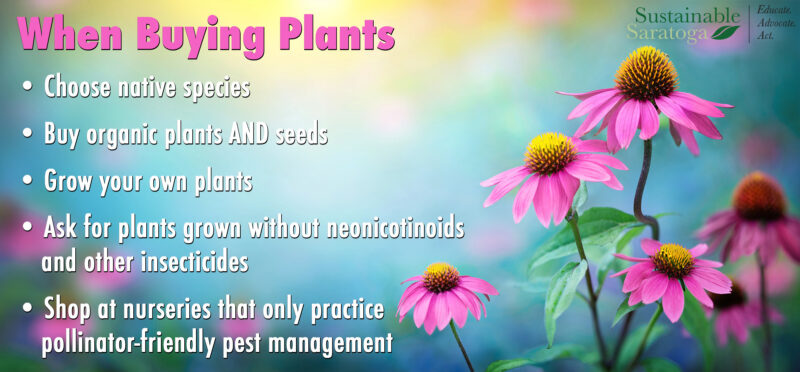
Pollinator-friendly plant lists:
Xerces Society guide for the Northeast Region
Audubon Society list by zip code
Lady Bird Johnson Wildflower Center list for NY state
Pollinator.org guide for our area
Pollinator-friendly plants may still be treated with pesticides, which can harm pollinators once they are planted at your home. The Xerces Society has some helpful resources to ensure that you are purchasing plants that are safe for bees and guidance for talking with nurseries about their practices.
Garnener or Guardian? You can be both! Watch our video to learn how.

Restrict or eliminate the use of artificial outdoor lighting
Scientific evidence is increasingly finding that light pollution negatively impacts nocturnal pollinators. Outside lights should be fitted with motion sensors that can’t be triggered by insects, or with timers to shut them off when no humans are around. Read our post about the importance of Dark Skies.
 Spread the word!
Spread the word!
Bee an advocate. Talk to your neighbors and friends.Put a sign up in your garden that says you have a pollinator-friendly garden. Ask your town or city to create pollinator-friendly habitat in parks and along roadways, and to stop using pesticides on government property. Xerces Society has some great resources to help you get started today.

READ MORE
Our friends at Saratoga Springs Public Library have put together a list of materials about pollinators: https://guides.sspl.org/pollinators
Where can you get locally grown native plants for your garden? Our annual Pollinator Palooza Native Plant Sale.
Have questions? Email us at pollinators@sustainablesaratoga.org

Take action!
WHAT: Bill S1856: The Birds and the Bees Protection Act (NY State)
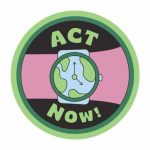 IMPACT: Prohibits the sale of certain pesticides or use of seeds coated with such pesticides, particularly neonicotinoids (neonics), which have been shown to cause great damage to pollinating insects and the birds that feed on them. Requires the DEC to review the latest scientific information concerning certain pesticide active ingredients.
IMPACT: Prohibits the sale of certain pesticides or use of seeds coated with such pesticides, particularly neonicotinoids (neonics), which have been shown to cause great damage to pollinating insects and the birds that feed on them. Requires the DEC to review the latest scientific information concerning certain pesticide active ingredients.
UPDATE– The Governor signed the bill!
WHAT: The U.S. Geological Survey Pesticide National Synthesis Project
IMPACT: This valuable US Geological Survey tool that tracks pesticide use and its impact on pollinators is being cut back. Read the article in Entomology Today.
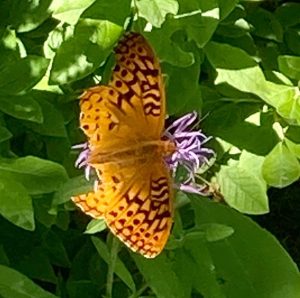 UPDATE: The USGS will continue to publish annual, county-level agricultural pesticide use estimates.
UPDATE: The USGS will continue to publish annual, county-level agricultural pesticide use estimates.

